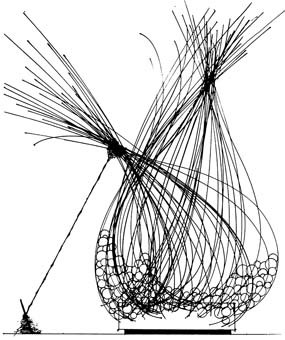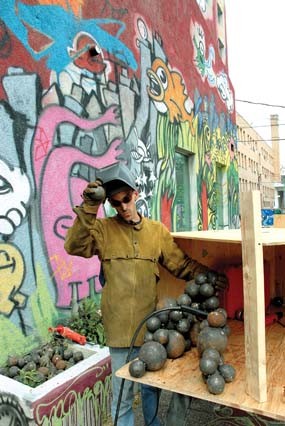Page 4 of 5

Present Tense under pressure
It seems everyone is banking on Present Tense to usher in the shake-up.n
The exhibition is a nice slice of who’s who in local contemporary art (see box, p. 27). Each artist has created stunning works that range from Alvey’s scientific exploration of emergent phenomenon, with Mason and Ball jars filled with found objects and stacked in an orderly fashion, to Wiemeyer’s 20-foot self-portrait in which he looks like Rasputin, affixed with mechanized shredder designed to eat away three inches of the painting every day until the show ends Sept. 27.

Dave Doman, who “had a few things lurking around the 337 building,” including the striking ’20s-flapper girl with the word “love” in red dimensional-style lettering, distanced himself a bit from his usual art-making process. He created a flower garden of Masonite 2-by-4s and miscellaneous scrap wood, with painted flowers placed on different levels to create a level of depth. “My favorite street texture is the cinderblock wall,” he says. “So I decided to try and bring that feeling into the gallery.”
“The public response made me realize that people do pay more attention to art in Salt Lake, so in that aspect, it definitely inspired me to feel good about making things,” Doman says of 337.

“I suspected at some point as curator of education I was going to be developing programming for it, and obviously I ended up inheriting a very different role in relation to the project as a whole,” Hueman says of his current position. “I didn’t want to conceive of educational programming that necessarily favored artists that I knew.”
Gray was only vaguely aware of the 337 building when he received a phone call from Hueman offering him a guest curator position for Present Tense. “He had a certain amount of aesthetic distance from 337. He wasn’t involved with the project; he’s not really that familiar with the artists’ personalities,” Hueman says. The distance, he says, allowed Gray to objectively consider Present Tense submissions in regard to contemporary art in Utah, nationally and globally, and to make a qualified selection that best reflected a cross-section of the 337 building.
Thomas adds, “Of course, there are always people who aren’t happy they weren’t chosen.”
Gray walked into his guest curator position with an open and optimistic mind. Though he was, “a little suspicious of the quality of work before I saw 337,” his visit to the building erased any doubts he might have had about submissions to Present Tense. The whole experience “has been a real eye-opener to the practice of contemporary art in Salt Lake City,” he says. “It’s broader and much more vibrant than what I thought it was.”